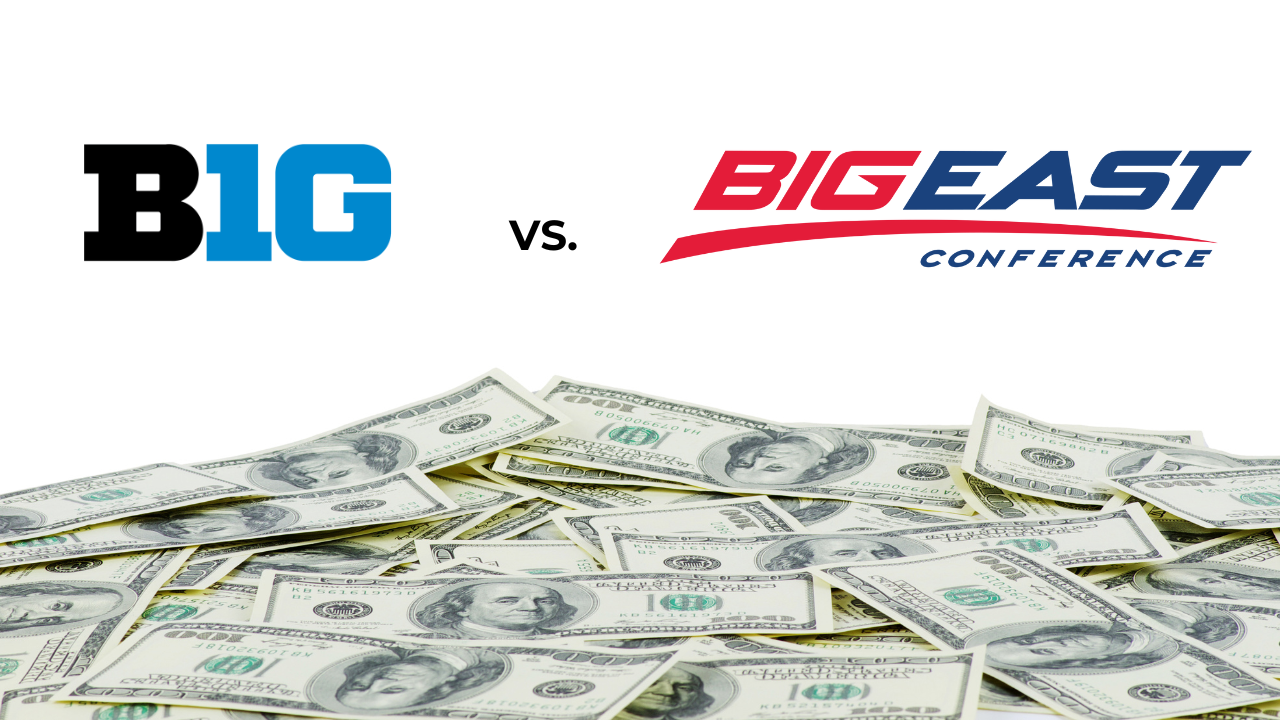I am a Creighton graduate – so take that with some level of bias. But, the reason for this paper is driven by my university. Recently, I was doom scrolling Twitter, and a fan from another Big East school put up the relative wages of the various Big East Schools. Creighton’s Mid-Career score was second to last. This upset me enough to do some research. This is a paper about that research.
Basically, I looked at mid-career wages, cost of living, and the cost to attend universities in the Big East and the Big Ten. The Big East is littered with private, mostly Catholic schools. The Big Ten has large state run universities. The Big Ten is clearly more research heavy, and the Big East is much more urban. Looking at the data, it does feel like Northwestern and UCONN should potentially trade conferences.
| University | City | Median Wage | Bachelor’s Wage | Delta | Cost of Univ | Cost of Living | Adj | True Wage | True ROI |
| Creighton | Omaha | 54980 | 99600 | 0.8115678429 | 31040 | 91.3 | 1.095290252 | $109,090.91 | $3.51 |
| Xavier | Cincinnati | 54910 | 98100 | 0.7865598252 | 32370 | 95.1 | 1.051524711 | $103,154.57 | $3.19 |
| Marquette | Milwaukee | 56190 | 114100 | 1.030610429 | 33566 | 97.3 | 1.027749229 | $117,266.19 | $3.49 |
| Butler | Indianapolis | 54090 | 109100 | 1.017008689 | 38643 | 91.4 | 1.094091904 | $119,365.43 | $3.09 |
| DePaul | Chicago | 61860 | 113800 | 0.839637892 | 31872 | 118.2 | 0.8460236887 | $96,277.50 | $3.02 |
| Villanova | Philadelphia | 61860 | 126900 | 1.051406402 | 33123 | 104.9 | 0.9532888465 | $120,972.35 | $3.65 |
| St. John’s | New York City | 74150 | 115200 | 0.5536075523 | 26655 | 144.8 | 0.6906077348 | $79,558.01 | $2.98 |
| Georgetown | Washington DC | 80480 | 141700 | 0.7606858847 | 23049 | 154.5 | 0.6472491909 | $91,715.21 | $3.98 |
| Providence | Providence | 60530 | 119100 | 0.9676193623 | 39566 | 113.8 | 0.8787346221 | $104,657.29 | $2.65 |
| Seton Hall | New York City | 74150 | 110000 | 0.4834794336 | 33177 | 120.9 | 0.8271298594 | $90,984.28 | $2.74 |
| Connecticut | Hartford | 67140 | 111000 | 0.6532618409 | 22168 | 104.7 | 0.9551098376 | $106,017.19 | $4.78 |
| University | State | Median Wage | University Wage | Delta | Cost of Univ | Cost of Living | Adj | True Wage | True ROI |
| Illinois | Illinois | 59650 | 123600 | 107.21% | 14272 | 92.6 | 1.079913607 | $133,477.32 | $9.35 |
| Indiana | Indiana | 50440 | 105200 | 108.56% | 13386 | 89.9 | 1.112347052 | $117,018.91 | $8.74 |
| Iowa | Iowa | 51140 | 108400 | 111.97% | 17599 | 89.2 | 1.121076233 | $121,524.66 | $6.91 |
| Maryland | Maryland | 65900 | 118600 | 79.97% | 17146 | 124 | 0.8064516129 | $95,645.16 | $5.58 |
| Michigan | Michigan | 55160 | 119400 | 116.46% | 19205 | 92.2 | 1.084598698 | $129,501.08 | $6.74 |
| Michigan State | Michigan | 55160 | 105900 | 91.99% | 8738 | 92.2 | 1.084598698 | $114,859.00 | $13.14 |
| Minnesota | Minnesota | 60480 | 112200 | 85.52% | 17468 | 97.4 | 1.026694045 | $115,195.07 | $6.59 |
| Nebraska | Nebraska | 52110 | 103700 | 99.00% | 18403 | 91.9 | 1.088139282 | $112,840.04 | $6.13 |
| Northwestern | Illinois | 59650 | 128000 | 114.59% | 29999 | 92.6 | 1.079913607 | $138,228.94 | $4.61 |
| Ohio State | Ohio | 53170 | 103800 | 95.22% | 19474 | 91.9 | 1.088139282 | $112,948.86 | $5.80 |
| Penn State | Pennsylvania | 55490 | 115200 | 107.60% | 24012 | 98.2 | 1.018329939 | $117,311.61 | $4.89 |
| Purdue | Indiana | 50440 | 112800 | 123.63% | 14619 | 89.9 | 1.112347052 | $125,472.75 | $8.58 |
| Rutgers | New Jersey | 67120 | 122000 | 81.76% | 11803 | 112.4 | 0.8896797153 | $108,540.93 | $9.20 |
| UCLA | California | 68510 | 129300 | 88.73% | 13393 | 137.6 | 0.726744186 | $93,968.02 | $7.02 |
| USC | California | 68510 | 133300 | 94.57% | 26021 | 137.6 | 0.726744186 | $96,875.00 | $3.72 |
| Wisconsin | Wisconsin | 53120 | 114000 | 114.61% | 13484 | 95.5 | 1.047120419 | $119,371.73 | $8.85 |
The two conferences also inhabit roughly the same geographic territory. Here are a couple of things that I noticed when doing this research. First, the price tag of the universities in the two conferences are significantly different. The Net Price calculation (which can be found on College Navigator’s page on https://nces.ed.gov) places every Big East school over $20k. This measurement is the true price that students pay. Schools like Georgetown have a lower cost to attend because of their generous financial aid to under-represented groups – even though their stated price tag is much higher.
Conversely, the Big Ten‘s two private schools plus Penn State are the only universities over $20k per year. Moreover, one university, Michigan State is particularly affordable – at under $10k. So, from a net price perspective, large public universities are clearly less expensive than Catholic private schools. This is easy analytically.
However, the real issue was not about price or Return on Investment. College graduation has been shown to have a huge impact on average lifetime wages. So, all of these colleges perform very well compared to the general median income of their region or home state. To do this analysis we compared the state (for the Big Ten) or the MSA (for the Big East). In many instances, you can see the relative data from a school in the other category because of the overlap in schools that inhabit the same geography. For example, one can examine Depaul to get underlying data about Chicago for Northwestern.
But, the logic behind the decision is that most Big Ten students will end up outside of their particular town – not all, but most. Whereas a high (often most) percentage of Big East graduates will stay in their urban environment. Imagine a place like Champaign-Urbana attempting to employ 5-8000 graduates per year from the University of Illinois. And the difference in cost of living is stark. Chicago (where many of the Champaign graduates more) is 20% above the average cost of living (according to COLI’s Q2 2022 data) compared to Champaign which is 20% below the national average. Thus, our attempt to standardize the data for Big Ten schools was an attempt to widen the footprint of graduates for many schools that are college towns. It’s not a perfect shift but it allows one to compare the conference more equitably.
And this is the crux of the problem with the analysis. These conferences cover a wide swath of the country. And, that wide swath includes the DC Metro which is nearly 50% higher cost of living, NYC which is nearly 40% higher, and the states of Indiana and Iowa which are 10% lower. Thus, the mid-career wages (of only those that achieved bachelor’s degrees) of a worker in Indianapolis cannot be compared in raw numbers to that of a person from Chicago, nor California to Wisconsin. In doing the adjustment of wages – called True Wage. My school, Creighton, actually finishes 4th in the Big East, well ahead of titan Georgetown. Some of this is likely because Creighton graduates a lot of doctors and lawyers that work in private practice rather than government, but this is also about the wild disparity in cost of living across this country.
The second big thing is that there is not a wild difference between Big Ten wages and Big East wages – toward private schools. If anything, it is the reverse. Mid-career graduates of Big Ten schools make significantly more than those from the Big East on average ($115.8k to $103.6k). Alumni are probably preparing to tell their private school brethren that they got ripped off. But, it is important to note a key component of Big Ten schools – they include a College of Engineering in most situations. These engineers consistently make higher salaries and make up a significant part of the alumni base. Thus, it is probably more noteworthy that certain schools do well compared to their in-state public school – Butler versus Indiana U. for example – than to claim that the education is “better”, etc. Regardless, it is true to my heart’s lament that University of Nebraska graduates make more on average in mid-career (according to Payscale) than do Creighton graduates.
What I do think is fairly obvious is how important our state institutions are to our overall economy. The delta between the average mid-career job from one of these schools and the state’s median wage is significant – the lowest delta is nearly 80% higher (Maryland). Moreover, the return on the cost of Maryland 6.61 per single year of tuition/single year of salary. [We could build a complicated NPV model – but many others have already done this.] I think it is more important to see the bigger message which is that universities are important to the success of economies. They produce talent that drives many economies.
Finally, I think it is important to return to the key part of this analysis. While the Big East provides private school opportunities central to many urban communities and while the Big Ten provides excellent public education for those same states and urban communities, the overlapping geography and analysis provides a real insight into the difference between the two conferences and their economics. Big Ten are about quantity (creating very large “n”s for the analysis). They produce thousands of graduates every year – including tens of thousands of engineers. And Big East schools produce smaller quantities but also excellent graduates in many professional positions. But, no matter which school you graduated from, it is important to recognize that the conferences and the institutions (though rivals) are critical keystones to the long-term success of the United States.









































